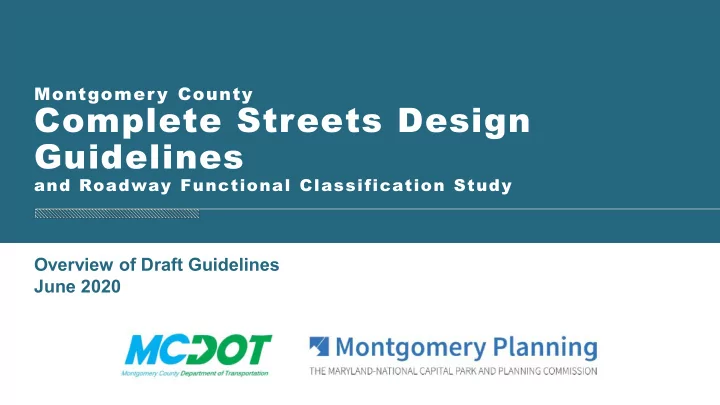

Montgomer y County Complete Streets Design Guidelines and Roadway Functional Classification Study Overview of Draft Guidelines June 2020
Agenda Background Process for Developing the Guide Overview of the Draft Guide Next Steps
Purpose To develop a comprehensive guide to street design in Montgomery County, with an emphasis on Complete Streets.
The guide is a critical component of implementing the County’s Vision Zero goal of eliminating traffic deaths by 2030
Context Supplements the Countywide Functional Master Plans, County Design Standards, Area Plans, and Bikeway Master Plan Primary emphasis is on county roads , though intended as advisory for state-owned roadways Some changes to Design Standards and County Code will be required for consistency with this new guidance Who will use this guide? County staff, developer/design consultants, the public
Process Background Research / Precedents Annotated Outline Guiding Principles Technical Work Sessions on Key Topics: Street Types Design Speed Corner Radius, Lane Encroachment, Design Vehicle Lane Widths, EMS Access Draft Guidelines We are here Public/Planning Board Review County Council Review Final Guidelines
Extensive Engagement To date: 4 design workshops with M-NCPPC and MCDOT/DPS leadership Developer Open House (May 2019) 15+ review meetings with staff design working group 3 rounds of review of draft content Draft sent to SHA for review/comment Next steps: Public Information Meeting – June 17 – virtual Developer/County Committees Public Hearing, Planning Board work sessions, T&E Review, Council Hearing
1 Vision 2 Street Types 3 Decision-Making Framework 4 Sidewalk Zone 5 Street Zone 6 Intersections 7 Green Streets 8 Bikeway 9 Speed Management 10 Implementation
Chapter 1 Vision Streets are vital to the quality of life for Montgomery County’s residents, workers, businesses, and visitors. Montgomery County’s Complete Streets Design Guide aims to create great places that are supported by safe and efficient transportation systems, which are equitably shared among diverse communities. The efficiency of these transportation systems will be enhanced by new guidance for designing new streets and reconstructing or retrofitting existing streets following the principles of Safety , Sustainability and Vitality .
Chapter 2 Street Types Each new street type prioritizes users and various design elements based on the context and character of the street. Based on roadway function and built environment Changes along segments of a roadway Focus is on new roads and reconstruction
Montgomery County Street Types Downtown Boulevard Neighborhood Yield Street Downtown Street Industrial Street Boulevard Country Connector Town Center Boulevard Country Road Town Center Street Major Highway Neighborhood Connector Neighborhood Street
Example: Downtown Boulevard
Special Streets Alleys Residential Shared Streets Commercial Shared Streets Rustic Roads / Exceptional Rustic Roads
Street Types linked to guidance on: Target speed Frontage Zone width # of vehicle lanes Maintenance Zone Protected crossing spacing Priority features in constrained ROWs Signalized intersection spacing Other street design elements (e.g., bike parking, crossing islands, raised Vehicle lane widths intersections, carshare parking, etc.) Median Bikeway width / type Street buffer width Ped Clear Zone width
Chapter 3 Decision-Making Framework This chapter is intended to serve as a quick, one-stop reference for the topics that are explained in greater detail in subsequent chapters.
Figure 3.2 (excerpt)
Figure 3.3
Figure 3.4 (excerpt)
Chapter 4 Sidewalk Zone Street Buffer Zone Pedestrian Clear Zone Frontage Zone Signage Transit Stops Open Section Roadways Driveways Street Lighting Maintenance Responsibilities
Chapter 5 Street Zone Curbside Zone Travelway Zone Median Zone Utilities Network Connectivity
Chapter 5 Street Zone Street Zone On-Street Parking Carshare Parking E/V Charging Mobile Food Vending Parklets In-Street Bike Corrals Commercial and Passenger Loading Zones Travel Lane Width Median Dimensions
Chapter 5 Street Zone Utilities Water and Sewer Gas Dry Utilities Utility Clearance Utility Appurtenances Network Connectivity Bike/ped and street connections between existing and new development
Chapter 6 Intersections Access Management Geometric Design Guidance Design Vehicles vs Control Vehicles Encroachment Mitigating Conflicts Intersection Features Roundabouts and Mini Roundabouts Curb Ramps Bikeways at Intersections Transit at Intersections Pedestrian Design Elements Channelized Right Turn Lanes
Chapter 7 Green Streets Urban Forestry Stormwater Management Tree/Plant Selection Opportunities and Constraints Tree Spacing and Clearances Incorporating BMPs into Street Design Street Trees and Landscaping Maintenance Soil Panels and Structural Soil Tree and Landscape Maintenance
Chapter 8 Bikeways Design Guidance Trails Separated Bikeways Striped Bikeways Bikeable Shoulders Shared Roads Breezeway Network Other Considerations Shy Zones Bicycle Ramps Green Paint
Chapter 9 Speed Management Design Speed, Target Speed, and Posted Speed Strategies for Achieving Target Speed Retrofitting Arterials for Lower Speed
Speed Management Techniques Road diet Lane diet Speed humps/cushions Speed tables/Raised crossings Raised intersections Curb extensions/Bulb outs Neckdowns/Chokers Crossing islands Traffic Diverters Chicanes/Roadway Curvature Textured Pavement Sense of Enclosure
Retrofitting Arterials for Lower Speeds Three hypothetical scenarios Existing Proposed
Chapter 10 Implementation Agency Responsibilities on Streets Project Development Process Permits and Approvals Design Exceptions
Next Steps Current project: Public information meeting – June 17 Informal meetings with developers/county committees Public hearing – July 23 Planning Board work sessions – September/ October 2020 County Council review – January 2021 Future efforts: Changes to County Code and Executive Regulations Update to Functional Master Plan of Highways and Transitways Ongoing updates – this is a living document
Questions? Steve Aldrich Andrew Bossi M-NCPPC MCDOT (301) 495-4528 (240) 777-7200 Stephen.Aldrich@MontgomeryPlanning.org Andrew.Bossi@montgomerycountymd.gov Dan Sheridan MCDOT (240) 777-7283 Daniel.Sheridan@montgomerycountymd.gov
Recommend
More recommend